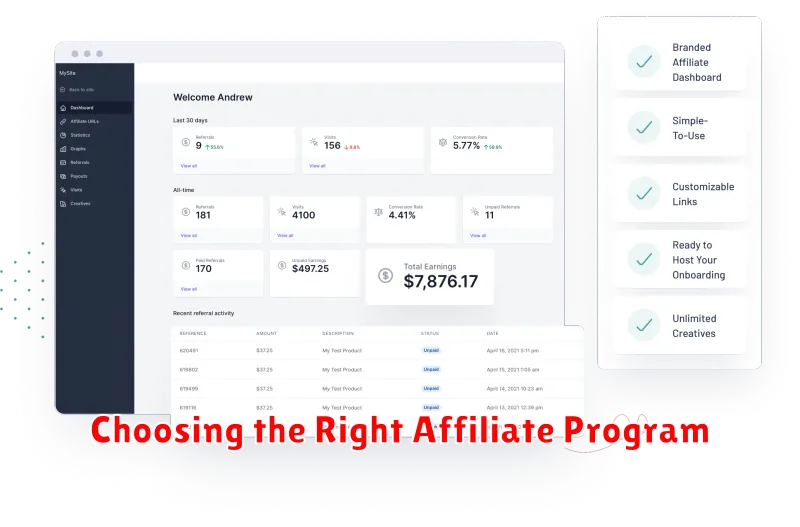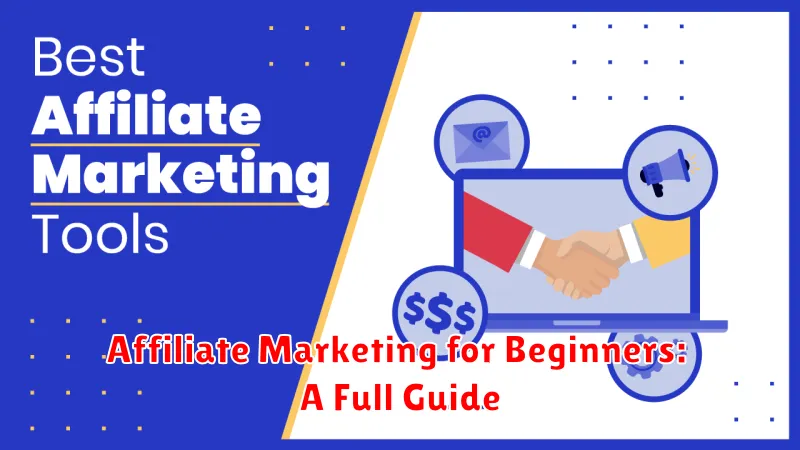Are you interested in learning about affiliate marketing? Do you want to earn passive income online? This comprehensive guide, “Affiliate Marketing for Beginners: A Full Guide,” will provide you with a strong foundation in the principles and practices of successful affiliate marketing. We’ll cover everything from understanding the basics of affiliate programs and choosing the right niche, to building a profitable affiliate marketing strategy. Whether you’re a complete beginner or have some experience, this guide is designed to help you navigate the world of affiliate marketing and start generating revenue.
Within this “Affiliate Marketing for Beginners: A Full Guide,” you’ll learn how to select high-converting offers and effectively promote them to your target audience. We’ll explore various affiliate marketing channels, including social media, email marketing, and content marketing. Discover how to build an engaged audience, track your affiliate marketing performance, and ultimately achieve long-term success in this dynamic and rewarding field. This guide will equip you with the knowledge and tools to become a proficient affiliate marketer.
What Is Affiliate Marketing?
Affiliate marketing is a performance-based marketing strategy where a business rewards one or more affiliates for each visitor or customer brought about by the affiliate’s own marketing efforts.
Think of it as a commissioned salesperson, but online. Instead of a physical storefront, affiliates use various online platforms like websites, blogs, social media, and email lists to promote a merchant’s products or services. When someone clicks on the affiliate’s unique link and makes a purchase, the affiliate earns a commission.
This model benefits both the merchant and the affiliate. The merchant gains broader reach and increased sales, while the affiliate earns passive income by promoting products they believe in. It’s a symbiotic relationship where success is shared.
The process typically involves three key players: the merchant (creator of the product/service), the affiliate (the marketer), and the customer (the end-user).
How Affiliate Models Work
Affiliate marketing operates on various models, each defining how affiliates earn commissions. Understanding these models is crucial for selecting the right partnerships and optimizing your earning potential.
Pay-per-sale (PPS) is the most common model. Affiliates earn a commission for each sale generated through their unique affiliate link. The commission is typically a percentage of the sale price.
Pay-per-lead (PPL) focuses on lead generation. Affiliates earn a commission for each qualified lead they deliver to the merchant. A “qualified lead” is typically defined by specific actions, such as completing a form, signing up for a trial, or requesting a quote.
Pay-per-click (PPC) rewards affiliates based on the number of clicks their affiliate link receives. This model is less common in traditional affiliate marketing and more prevalent in advertising networks.
Pay-per-impression (PPI) is based on the number of times an ad or link is displayed. Like PPC, this model is less prevalent in typical affiliate marketing programs.
Choosing the Right Affiliate Program

Selecting the right affiliate program is crucial for success in affiliate marketing. Aligning with products or services that resonate with your audience is paramount. Consider your niche and the interests of your followers when making your decision.
Relevance is key. Promoting products that complement your content builds trust with your audience and increases the likelihood of conversions. For example, if your platform focuses on healthy living, partnering with fitness or nutrition companies would be a natural fit.
Commission structure varies significantly between programs. Some offer a flat fee per sale, while others provide a percentage of the sale price. Research different structures to find one that aligns with your earning goals.
Evaluate the reputation of the program and the merchant. Partnering with reputable companies ensures reliable tracking, timely payments, and quality products, ultimately benefiting both you and your audience.
Consider the support offered by the affiliate program. A responsive and helpful support team can assist with technical issues, tracking queries, and marketing materials, contributing to a smoother experience.
Creating Content That Converts
Creating high-quality content is crucial for affiliate marketing success. It’s not enough to simply publish anything; your content needs to resonate with your target audience and encourage them to take action. This action, known as conversion, is most often a click on your affiliate link, leading to a sale.
Focus on providing value to your audience. This could be in the form of informative articles, helpful tutorials, comprehensive product reviews, or engaging videos. Understand your audience’s needs and create content that directly addresses those needs. Think about what problems they face and how your recommended products can offer solutions.
Keywords play an essential role in attracting organic traffic. Research relevant keywords related to your niche and incorporate them naturally within your content. Avoid keyword stuffing, as this can negatively impact your search engine rankings. Instead, prioritize creating valuable and engaging content that incorporates keywords strategically.
A clear call to action is essential. Tell your audience exactly what you want them to do, whether it’s clicking a link, visiting a website, or signing up for a newsletter. Make it easy for them to take the next step. Use strong verbs and compelling language to motivate your audience to convert.
Disclosure and Legal Guidelines
Affiliate marketing involves legal and ethical responsibilities. Transparency is paramount. You must clearly disclose your affiliate relationships to your audience. This means informing them that you may receive a commission for purchases made through your recommendations.
The Federal Trade Commission (FTC) in the US regulates affiliate marketing disclosures. These disclosures must be clear and conspicuous. Avoid vague language or burying the disclosure in fine print. Place it near the affiliate link, ensuring your audience sees it before clicking.
Accuracy is also crucial. Only promote products or services you believe in. Don’t make misleading claims or exaggerate benefits. Your credibility is essential for long-term success in affiliate marketing.
Familiarize yourself with the specific platform guidelines where you promote affiliate offers. Each platform (e.g., social media, blogs) may have its own rules regarding disclosures and promotions. Compliance is vital to maintaining your accounts and reputation.
Building an Email List for Promotion
Building an email list is crucial for successful affiliate marketing. It allows you to directly communicate with a targeted audience interested in your niche. This provides a platform for promoting affiliate products beyond the limitations of relying solely on search engine traffic or social media algorithms.
Start by offering a lead magnet. This could be a free ebook, checklist, or discount code in exchange for an email address. Use a dedicated email marketing service to collect and manage subscriber information. Respect user privacy and clearly communicate the value proposition of joining your list.
Once you start building your email list, segment your subscribers based on their interests or interactions. This will allow you to personalize email campaigns and recommend products that align with their specific needs. Regularly provide valuable content to build trust and establish yourself as an authority in your niche. Don’t just promote products; offer helpful information, insights, and resources.
Finally, track the performance of your email marketing efforts. Monitor open rates, click-through rates, and conversion rates to identify what resonates with your audience and refine your approach. This data-driven approach is key to maximizing the effectiveness of your affiliate promotions.
Optimizing Affiliate Links
Optimizing your affiliate links is crucial for maximizing your earning potential. This involves making your links user-friendly and enticing, while also tracking their performance to understand what resonates with your audience.
Cloaking your affiliate links is a common practice. This involves using a URL shortener or a plugin to mask the long, complex affiliate link with a shorter, more branded URL. This improves the aesthetics of your content and builds trust with your audience.
Strategic placement of your affiliate links is essential. Don’t overwhelm your audience with excessive links. Instead, integrate them naturally within your content, ensuring they are relevant to the surrounding context. Placing links within call-to-actions or at the end of product reviews are effective strategies.
Tracking the performance of your affiliate links is paramount. Use analytics tools provided by your affiliate program or third-party platforms to monitor clicks, conversions, and other key metrics. This data allows you to identify which links are performing well and which ones need adjustments. By analyzing this data, you can optimize your strategies and improve your overall conversion rates.
Tracking and Analyzing Results
Tracking your affiliate marketing efforts is crucial for understanding what works and what doesn’t. Utilizing various methods allows you to monitor your progress and optimize your campaigns for better results.
Affiliate networks usually provide built-in tracking tools that record clicks, conversions, and sales generated through your affiliate links. These dashboards offer valuable insights into which products or campaigns are performing best.
You can also use third-party tracking software for more advanced analytics. These tools can offer granular data on user behavior, conversion rates, and other key metrics.
Analyzing your collected data is the next essential step. Look for patterns and trends to identify your most successful strategies. For example, which traffic sources are driving the most conversions? Which products are generating the highest revenue?
By regularly analyzing your results, you can refine your approach, focus on high-performing strategies, and ultimately maximize your affiliate marketing earnings.
Passive Income Potential
One of the most attractive aspects of affiliate marketing is its potential to generate passive income. This means you can earn money even while you’re not actively working. Once you’ve set up your affiliate campaigns, content, or systems, they can continue to generate revenue with minimal ongoing effort.
Imagine creating a comprehensive product review that ranks highly in search engine results. This single piece of content could attract a steady stream of potential customers for months or even years to come, leading to consistent affiliate commissions. While initial setup requires work, the potential for long-term, passive earnings is a significant draw for many affiliate marketers.
However, it’s important to understand that “passive” doesn’t mean “effortless.” Building a successful passive income stream through affiliate marketing requires strategic planning, high-quality content creation, and ongoing optimization to maintain visibility and effectiveness. It’s an investment of time and effort upfront, with the potential for rewarding returns over the long run.
Common Pitfalls for New Affiliates
New affiliate marketers often encounter several challenges that can hinder their success. One common mistake is choosing the wrong niche. Selecting a niche that is too broad, too competitive, or doesn’t align with your interests can make it difficult to stand out and generate traffic. Thoroughly research and select a niche that you understand and can contribute valuable content to.
Another pitfall is focusing solely on promoting products without providing value to your audience. Building trust with your audience is essential for long-term success. Instead of solely pushing products, focus on creating high-quality content that educates and informs your audience, subtly weaving in affiliate promotions.
Ignoring SEO (Search Engine Optimization) is another common mistake. Optimizing your content and website for search engines is crucial for driving organic traffic to your platform. Learn the basics of keyword research, on-page optimization, and link building to improve your search engine rankings and increase visibility.
Finally, many new affiliates fall into the trap of lack of patience. Building a successful affiliate marketing business takes time and effort. Don’t get discouraged if you don’t see results immediately. Stay consistent with your content creation and marketing efforts, and track your progress to identify areas for improvement. Success in affiliate marketing requires dedication and perseverance.

